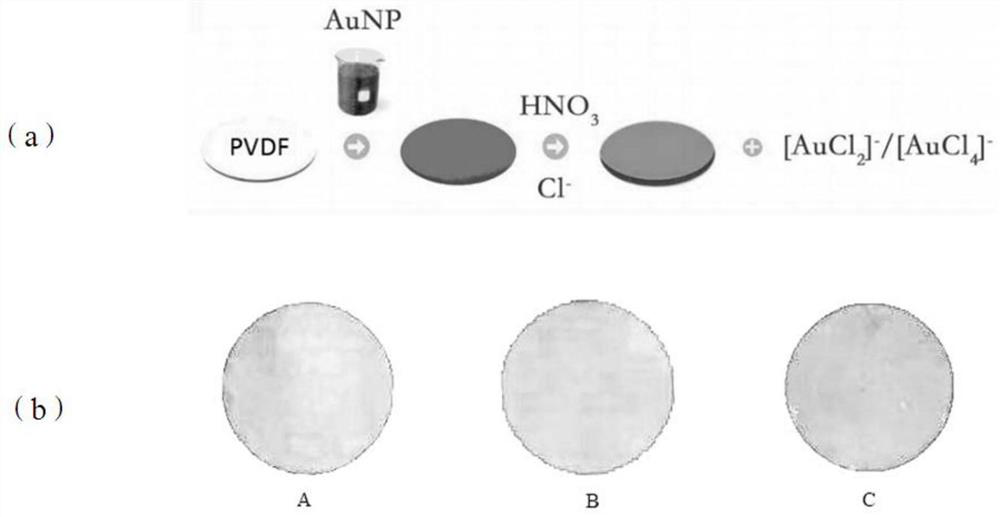Method for detecting content of chloride ions in body fluid through dendritic gold nanoparticles
A technology of gold nanoparticles and chloride ion content, applied in the field of chloride ion detection, can solve the problems of high cost, cumbersome detection, unsuitable application, etc., and achieve the effects of good selectivity, strong detection specificity, and good anti-interference ability.
- Summary
- Abstract
- Description
- Claims
- Application Information
AI Technical Summary
Problems solved by technology
Method used
Image
Examples
Embodiment 1
[0039] The present embodiment prepares dendritic gold nanomaterials:
[0040] A two-step method was employed to synthesize dendritic gold nanoparticles. First use the sodium citrate reduction method to synthesize 20nm spherical gold nanomaterials as seeds, and place a 250ml three-neck flask with 99mL ultrapure water in an oil bath to heat while stirring, and add 1mL after the water boils to a concentration of 1%. Sodium citrate solution, after a few minutes, the solution turns wine red, and then heated for half an hour, to prepare spherical gold nano-seeds;
[0041] Add the following solutions in turn to a 20 mL glass bottle with a cap filled with 5 mL of ultrapure water: 30 μL of 1% chloroauric acid solution, 31 μL of spherical nanoseed solution, 11 μL of 1% sodium citrate solution, 50 μL of hydroquinone solution with a molar concentration of 30 mmol / L. Shake quickly, and then stand for 20 minutes. When the solution turns blue, it means that the dendritic gold nanomaterials...
Embodiment 2
[0044] This embodiment prepares paper fund nanomaterials:
[0045] Use a puncher to punch polyvinylidene fluoride membrane (PVDF membrane) into paper pieces with a diameter of 5mm, take 10 pieces of paper and add them to 2mL dendritic gold nanoparticle solution and soak for 5 hours, and observe the color of the PVDF membrane. , use tweezers to take out the paper sheet, rinse it with ultrapure water, place it on a dry filter paper and let it air dry naturally to obtain a paper-based nanomaterial.
Embodiment 3
[0047] Chloride ion detection using paper-based nanomaterials:
[0048] Place the prepared paper fund nanomaterials in the following conditions: (1) 1.25mL concentrated nitric acid solution (16mol / L), (2) 1.25mL sodium chloride solution (1%), (3) 250μL sodium chloride (1%) and 1mL concentrated nitric acid (16mol / L) mixture. Place them at room temperature to react for 50 minutes, then take out the test paper sheet with tweezers, rinse it with ultra-pure water, place it on a dry filter paper to air dry and take pictures, observe the color of the gold nano test paper, and compare the color changes of the gold nano test paper under different conditions.
[0049] Such asfigure 1 Shown is the feasibility analysis diagram of dendritic gold nanomaterials for detecting sodium chloride; the figure (a) shows that when only concentrated nitric acid solution exists, the color of the PVDF membrane loaded with gold nanoparticles does not fade, and it still presents the original blue color. ...
PUM
| Property | Measurement | Unit |
|---|---|---|
| diameter | aaaaa | aaaaa |
| diameter | aaaaa | aaaaa |
Abstract
Description
Claims
Application Information
 Login to View More
Login to View More - R&D
- Intellectual Property
- Life Sciences
- Materials
- Tech Scout
- Unparalleled Data Quality
- Higher Quality Content
- 60% Fewer Hallucinations
Browse by: Latest US Patents, China's latest patents, Technical Efficacy Thesaurus, Application Domain, Technology Topic, Popular Technical Reports.
© 2025 PatSnap. All rights reserved.Legal|Privacy policy|Modern Slavery Act Transparency Statement|Sitemap|About US| Contact US: help@patsnap.com



